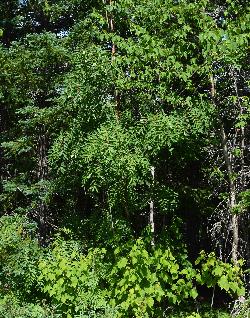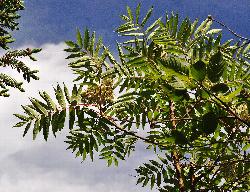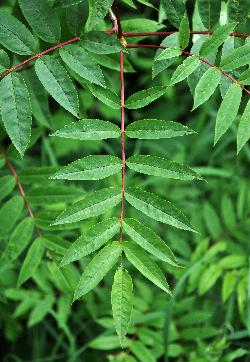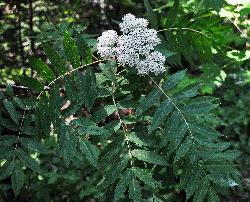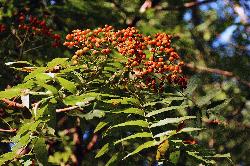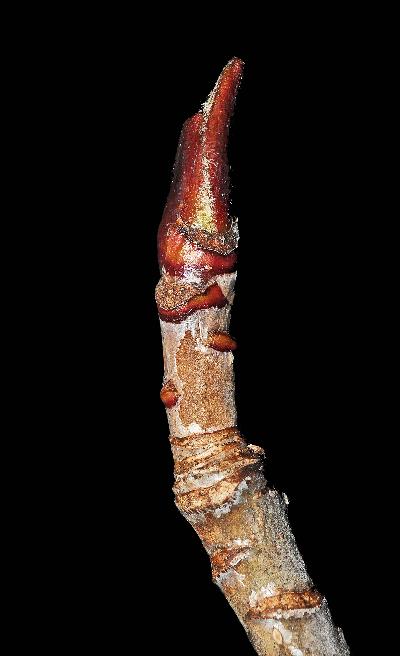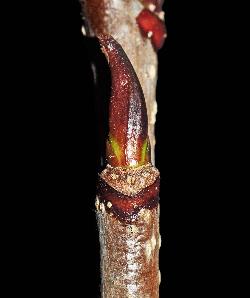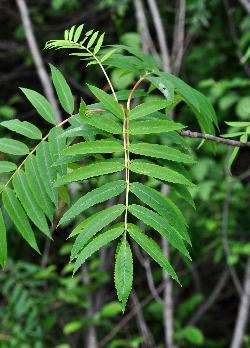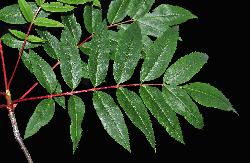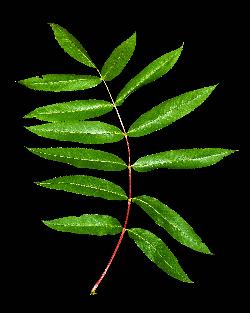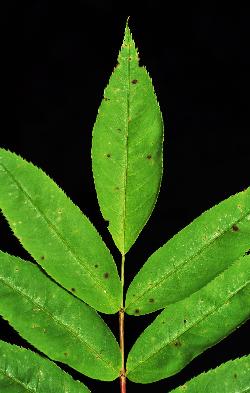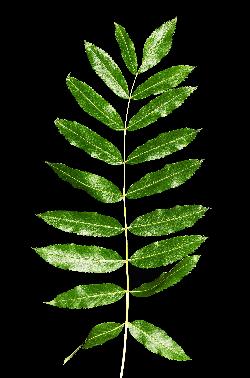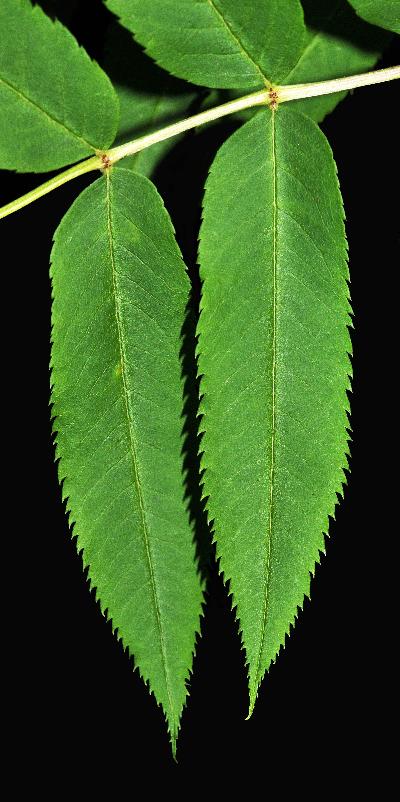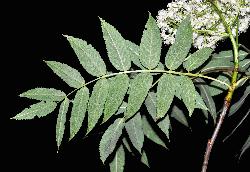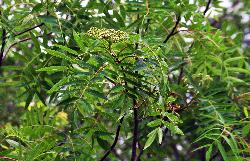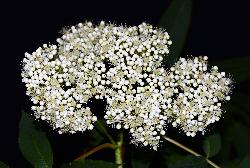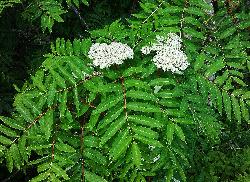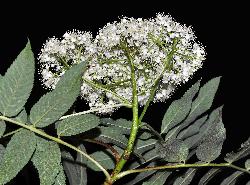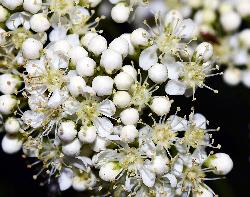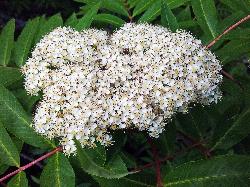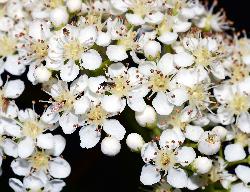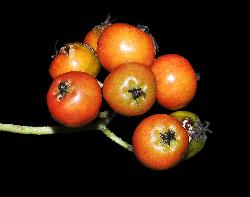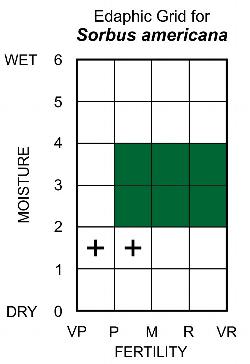Fr: sorbier d'Amerique, cormier, maska, maskouabina
IA: mashkumin(an)akashi, mashkumin(an), tetamin
Rosaceae - Rose Family
Note: Numbers provided in square brackets in the text refer to the image presented above; image numbers are displayed to the lower left of each image.
General: A tall, open, deciduous shrub or small tree, 4–9 m tall, with an average stem diameter at breast height (d.b.h.) of 10–25 cm (Sullivan 1992b) [1–3]. It bears large clusters of numerous white flowers that are followed by clusters of red-orange to red fruit. American mountain ash is reportedly shade-intolerant and will not survive following fire, but can sprout from the stump if not severely burnt (Sullivan 1992b). American mountain ash provides browse for moose, as well as pine marten, hares, and ruffed grouse, while the fruit are eaten by a variety of small mammals and frugivorous birds (Sullivan 1992b). American mountain ash hybridizes in insular Newfoundland with purple chokeberry (Aronia ×prunifolia (Marshall) Rehder) to produce Jack’s sorbaronia (×Soraronia jackii Rehder). Warning: While not considered to be poisonous, all mountain ash species contain low levels of cyanogenic glycosides; the wilted foliage and seeds contain higher concentrations of this chemical and should not be consumed. When mashed or chewed, mountain ash seeds release hydrogen cyanide (HCN), a poisonous gas; however, ingestion of large quantities of seeds is required to produce serious problems (Poulton 1983, Ebinger and Bergman 1987).
Key Features:
- Leaves alternate, pinnately compound, with 11–17 lanceolate-oblong to lanceolate leaflets that taper gradually to a long acuminate apex. Leaflets are roughly 3–5 times as long as wide. The petiole and upper surface of the rachis are red [4].
- Numerous flowers are arranged in large flat-topped to domed inflorescences [5], to 15 cm across; individual flowers are 5–7.5 mm across and have 5 white petals, 14–20 stamens, and an inferior ovary.
- Large clusters of orange to red-orange fruit (pomes), 4–7 mm in diameter [6].
Stems/twigs: Main stems usually 1–4; the trunks have grayish-brown, smooth bark; twigs are stout, glabrous, and silvery-grey or greyish-brown to dark reddish-brown. Both terminal and alternate lateral buds are present. The terminal bud is conical, glutinous, and 0.7–2 cm long [7]. Both terminal and lateral buds are large, lanceolate, dark reddish-brown or purplish-brown, sticky (glutinous), and may be slightly curved at the tip [8]. The outer bud scales are glabrous and lustrous, while inner scales have ciliate margins of short whitish to reddish-brown (rufous) hairs. Leaf scars are narrow, broadly U-shaped, and have 5 bundle trace scars arranged in a row [8].
Leaves: Alternate, pinnately compound, usually with 11–19 leaflets, and petiolate [9–11]. The petiole and rachis are reddish, at least on the upper surface, and pale yellow on the lower surface. Lateral leaflets are lanceolate-oblong to lanceolate and sessile to very short-stalked, and arranged in opposite pairs [11], while the terminal leaflet is elliptic to lanceolate, with a long stalk (petiolule) [12]. Occasionally, the terminal leaflet may be partially divided, producing an unequal terminal pair [13]. Leaflet blades are 5–10 cm long by 1–2.5 cm wide (3.4–5 times as long as broad). Bases are tapering to rounded and slightly oblique (with the blade longer on the lower side of the midrib); the apex narrows gradually to an acuminate or long-acuminate point [14]. Margins are sharply serrate or double-serrate above the base, which has entire margins [15]. Leaflet surfaces are yellowish-green to dark green and glabrous or glabrate above; the lower surface is paler and glabrous to slightly hairy along the midrib [16–17]. Leaves turn yellow in autumn.
Flowers: Bisexual, white, numerous (125–400+), in a terminal, branched, flat to dome-shaped inflorescence (compound cyme), 6–15 cm across [18–20]. The peduncle, inflorescence branches, and pedicels are glabrous to very sparsely pubescent with scattered villous hairs [21]. Flowers are about 5–7.5 mm across and have a glabrous hypanthium with 5 short-triangular calyx lobes. Attached along the rim of the hypanthium are 5 ovate to orbicular concave short-clawed white petals, 2–2.5 mm long, and 14–20 stamens, which have white filaments and white to light pinkish-brown anthers [22]. The pistil has an inferior ovary of 2–5 carpels, partially adnate to the hypanthium, and 3–4 styles, 1.5–2 mm long, each ending in a small yellow capitate stigma [22]; the summit of the ovary is densely white-pubescent. The scent of dogberry flowers is often described as a disagreeable odour. Flowers bloom in late spring to mid-summer (June-early July) about 1 week earlier than flowers of showy mountain ash. Pollination is carried out by a variety of insect species (entomophily), usually small bees and flies [23–24].
Fruit: A broad cluster of small berry-like fruit (pomes) [6, 25]; individual pomes are globose, 4–7 mm in diameter, and mature from green to orange to bright red; mature fruiting stalks (pedicels) are green to reddish; the small calyx lobes are incurved to somewhat erect fruit [26]. The flesh of the pomes is pale yellow-orange and bitter [27]; mature seeds are 2.5–3.3 mm long by 1.5–2 mm wide and light brown. Fruits mature in late summer to early autumn (August–September), but remain on the branches throughout winter. As in showy mountain ash, dispersal is by frugivorous birds, particularly waxwings and grosbeaks, which consume the fruit and regurgitate or defecate the seeds (endozoochory).
Ecology and Habitat: American mountain ash occurs in low abundance on moist to wet, medium to nutrient-rich soils. It is considered shade-tolerant, but is more abundant in early than in mature stages of coniferous forest succession (Sullivan 1992b).
Edaphic Grid: See image [28]: the Edaphic Grid for Sorbus americana.
Forest Types: American mountain ash is absent from Labrador, but has been recorded in the following forest types in insular Newfoundland:
- Abietum clintonietosum (Clintonia-Balsam Fir Forest Subassociation)
- Abietum dryopteretosum (Dryopteris-Balsam Fir Forest Subassociation)
- Abietum gaultherietosum (Gaultheria-Balsam Fir Forest Subassociation)
- Abietum rubetosum (Rubus-Balsam Fir Forest Subassociation)
- Abietum taxetosum (Taxus-Balsam Fir Forest Subassociation)
- Aceretum galietosum (Galium-Mountain Maple Thicket Subassociation)
- Betuletum dryopteretosum (Dryopteris-Birch Forest Subassociation)
- Betuletum rubetosum (Rubus-Birch Forest Subassociation)
- Kalmio-Piceetum typicum (Kalmia-Black Spruce Forest Subassociation)
- Sphagno-Piceetum (Sphagnum-Black Spruce Bog Association)
Succession: American mountain ash can increase in abundance through root sprouting following low intensity fire and harvesting, but rarely attains dominance. It is generally poorly adapted to survive frequent or intense fires. It can also recover from moose browsing through sprouting. American mountain ash is shade-tolerant and can persist in low frequency and abundance into mature stages of stand development with about 10–50 stems/ha (Sullivan 1992).
Distribution: American mountain ash is native to north-temperate and southern-boreal eastern North America; its range extends from insular Newfoundland west throughout southern and central regions of Ontario, extending as far north as the Moose River Drainage Basin (ca. 51° N) (Soper & Heimburger 1982). In Newfoundland, it occurs from the northern Avalon Peninsula across the Island to western Newfoundland, but is uncommon along southern coastal regions (Rouleau and Lamoureux 1992). In the United States, American mountain ash extends from New England south along the Appalachians to northern-most Georgia and west along the states bordering the Great Lakes from New York to northeastern Minnesota, but is absent from Ohio and Indiana (USDA, NRCS 2016).
Similar Species: Showy mountain ash (Sorbus decora (Sarg.) C.K. Schneid.), is similar to American mountain ash, but has shorter, more oblong leaflets that taper abruptly to a short-acuminate apex and larger red-orange to red pomes, each 7–12 mm in diameter. The leaflets of mature showy mountain ash leaves are 2–3.2 longer than wide, compared to leaflets of American mountain ash, which are 3.5–5 times longer than wide and taper gradually to a long acuminate apex.
In urban areas, the European mountain ash (Sorbus aucuparia L.), also known as dogberry or rowan tree, is frequently planted and may spread to adjacent natural areas by frugivorous birds. European mountain ash can be distinguished by its buds, which are not glutinous and are covered with white tomentose hairs, its more pubescent young branches, the more densely pubescent lower surface of its leaflets, and its more golden-orange pomes (6–9 mm across), although fruit colour varies with different cultivars.
Red elderberry (Sambucus racemosa L. var. pubens (Michx.) Trautv. & C.A. Mey.) has pinnately compound leaves and large white-flowered inflorescences similar to those of mountain ash species, but the leaves of red elderberry have only 5–7 leaflets and the white flowers are arranged in an elongate or pyramid-shaped inflorescence. The flowers of red elderberry have an inconspicuously toothed green calyx, a white corolla with 5 rounded lobes, only 5 stamens, and a pistil with an inferior ovary; fruits are small iridescent red berry-like drupes 4–6 mm long.


